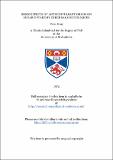Files in this item
Some effects of anticonvulsant drugs on sugar uptake by cerebral cortex slices
Item metadata
| dc.contributor.advisor | Gilbert, J. C. | |
| dc.contributor.author | Gray, Peter | |
| dc.coverage.spatial | 93 p. | en_US |
| dc.date.accessioned | 2018-06-15T09:23:30Z | |
| dc.date.available | 2018-06-15T09:23:30Z | |
| dc.date.issued | 1972 | |
| dc.identifier.uri | https://hdl.handle.net/10023/14100 | |
| dc.description.abstract | Xylose, a sugar not metabolised by brain, and glucose may be transported into brain by a common mechanism (Gilbert, 1965). In the present studies the effects of some anticonvulsant drugs on the uptake of xylose by the non-raffinose compartment of cerebral cortex slices have been examined. The slices were pre-incubated for 30 minutes in oxygenated bicarbonate media, containing pyruvate as nutrient, and raffinose, before transfer to similar media containing xylose. Employing an incubation time of 9 minutes, and a xylose concentration in the medium of 50 mM, it was found that the anticonvulsant drugs acetazolamide, 20 µM, and ethosuximide, 500 µM, caused an increase in xylose uptake, while diphenylhydantoin, 100µM, was without effect in this respect,-SH group blocking agents (5,5- dithiobis (2~nitobenzoic acid), 100µM, or iodoacetamide, 100 µM), did not appear to affect 'basal' xylose uptake by the slices, but prevented stimulation of xylose uptake by acetazolamide or ethosuximide. Studies of the initial velocity of xylose uptake by the slices, over a range of medium xylose concentrations, indicated that the xylose uptake process appeared to conform to Michaelis-Menten kinetics; the apparent Km (under control conditions) for xylose being 87 mM, and the Vmax. being 30 millimole, 1iter of intracellular water-1minute-1. Acetazolamide increased both the Km and Vmax. of the xylose transport process. Both these parameters were decreased by ethosuximide. The effect of phenobarbitone on the kinetics of xylose uptake by cerebral cortex slices has been found (Gilbert, Ortiz, and Millichap, 1966) to resemble that recorded here for ethosuximide. The anticonvulsants which have been shown to be capable of increasing xylose uptake by brain slices also increased brain glucose content 'in vivo' (Gilbert, Gray, and Heaton, 1971), - probably as a consequence of a stimulation of glucose transport into brain rather than a depression of cerebral metabolism. The uptake of glucose may, under certain conditions, be the rate - limiting factor in its metabolism by brain (Joanny, Gorriol, a Hillman, 1969; Buschiazzo, Terrell, and Regen, 1970), Glucose may also have a direct stabilizing effect on brain cells (Goldman and Good, 1969)* The stimulation of sugar uptake 'brought about by the drugs might thus contribute to their anticonvulsant effect However, the interaction of these drugs with cerebral membranes may, in addition to affecting permeability to sugars, result in other effects more directly responsible for their anticonvulsant efficacy. | en_US |
| dc.language.iso | en | en_US |
| dc.publisher | University of St Andrews | |
| dc.subject.lcc | QP923.G8 | |
| dc.subject.lcsh | Individual chemical substances | en |
| dc.title | Some effects of anticonvulsant drugs on sugar uptake by cerebral cortex slices | en_US |
| dc.type | Thesis | en_US |
| dc.type.qualificationlevel | Doctoral | en_US |
| dc.type.qualificationname | PhD Doctor of Philosophy | en_US |
| dc.publisher.institution | The University of St Andrews | en_US |
This item appears in the following Collection(s)
Items in the St Andrews Research Repository are protected by copyright, with all rights reserved, unless otherwise indicated.

